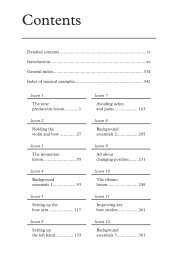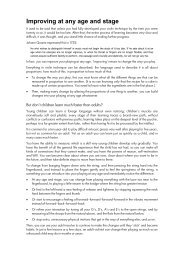Introduction (excerpt) - Simon Fischer
Introduction (excerpt) - Simon Fischer
Introduction (excerpt) - Simon Fischer
- No tags were found...
Create successful ePaper yourself
Turn your PDF publications into a flip-book with our unique Google optimized e-Paper software.
On a practical, physical level of violin technique, there is not so much to know about. There are all thethings you have got to learn to do; and all the things to learn not to do. Yet all this amounts to only a fewprinciples about how to hold the instrument and bow, how to use each hand in all the various ways, andso on. The list of ‘things you need to know and do’ is not endless, and is not even very long.The Violin Lesson covers the main areas where you can easily and noticeably make a difference. Whilenot every subject is for everyone, The Violin Lesson has something in it for every level and type of player –elementary or advanced, amateur or professional, teacher or student.Can you improve your playing by reading a book?No book can replace a teacher or the living, practical experience of playing or listening to music. Butgaining information from a book, or gaining that information through having somebody listen to you playand then saying those same things to you, can often be the same thing in the end.If you want to change the way you play the violin, you have to change the way you think about playingthe violin. You can do that by practising or by going to a concert, and by many other means; but readingabout, say, tone production, can so change your picture of bowing the string that your whole approachchanges immediately and dramatically – even before you have actually put the bow on the string andstarted to try things out.Q But the points in a book can only be general ones. In a lesson the teacher deals with your specific,individual needs.Everyone has their own unique set of physical, technical and musical characteristics, their own particulargifts, problems, strengths and weaknesses; yet the same technical and musical points tend to appearagain and again, and in the same way, in most players.Typical technical points in the left arm include freeing the thumb; moving the fingers freely from thebase joints, without partly moving them from the hand or forearm; widening the hand at the basejoints, rather than contracting; fingers remaining light without over-pressing; co-ordination, and thefundamentals of vibrato, intonation, shifting and so on.Typical technical points in the right arm include the basics of how to make a pure and expressivetone; fundamentals of the bow hold; the mechanics of drawing a straight bow; how to improve keystrokes like spiccato or martelé, and so on.There are actually quite a limited number of technical problems that you can have, and they tend to cropup in the same ways all the time. So the topics and issues that are explored in The Violin Lesson mayeasily be exactly those that you need to explore yourself.Suppose your left hand does not feel comfortable. You do not necessarily need someone to look at whatyou, specifically, are doing, and make suggestions that are tailored only to you. The same principles aregoing to apply to you as to anyone else.Building a good left hand position, or strengthening intonation, or developing tone or vibrato, or gainingconfidence in shifting, is almost entirely the same process whoever you are, and whatever your age orstandard.Q What about different ‘schools’ of playing? How do I know what is right for me? Is it not best to stick towhat my teacher tells me, to avoid any contradiction or confusion?There have been many different approaches to technique around the world, and from age to age,usually stemming from, or based around, one particular player’s or teacher’s approach. Different schoolsof playing favour certain distinctive bow holds, or certain approaches to tone or vibrato. However, allthe different approaches are united by natural laws and principles.These natural laws of cause-and-effect, proportion, leverage and balance, must apply whatever theapproach or philosophy of playing, so there should be no danger of contradiction.Q What is an example, in practical violin terms, of a ‘law’ that must apply whatever the school ofplaying?How far away from the thumb should the first finger sit on the bow?






